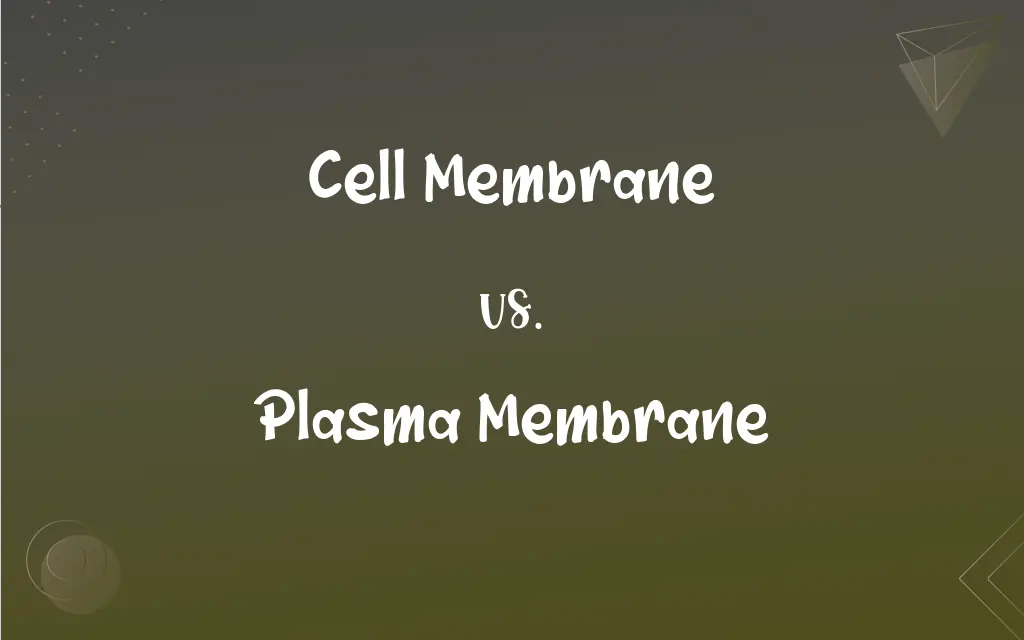Cell Membrane vs. Plasma Membrane: What's the Difference?
Edited by Janet White || By Harlon Moss || Updated on October 27, 2023
The cell membrane and plasma membrane refer to the same structure, acting as a barrier around the cell.

Key Differences
The cell membrane and plasma membrane are terms that often cause confusion, even though they describe the same cellular structure. The primary purpose of the cell membrane is to act as a boundary, separating the internal components of the cell from its external environment. Similarly, the plasma membrane serves this exact function, protecting and encompassing the cell's inner workings.
Both the cell membrane and the plasma membrane have a unique composition. This lipid bilayer, filled with proteins and other molecules, ensures selectivity in what enters and exits the cell. Thus, whether you refer to it as the cell membrane or the plasma membrane, you're speaking about a structure that ensures cellular integrity and regulates the movement of substances.
In some contexts, the term "cell membrane" is preferred, especially in elementary biological discussions. It gives a general idea about the cell's outer boundary. In contrast, "plasma membrane" is often used in more advanced biological contexts, emphasizing the fluid-like nature of the membrane and its specific compositions and functions.
Regardless of the nomenclature - cell membrane or plasma membrane - the importance of this structure in maintaining cellular homeostasis cannot be understated. It's responsible for selective permeability, allowing certain substances in while keeping others out, ensuring the cell functions correctly.
In summary, while the terms cell membrane and plasma membrane might be used in different contexts, they refer to the identical structure, which plays a pivotal role in cellular function and maintenance. Both terms highlight the membrane's significance in biology and medicine.
ADVERTISEMENT
Comparison Chart
Terminology Usage
Common in basic biology
Often used in advanced biology
Definition
Outer boundary of the cell
Lipid bilayer surrounding the cell
Composition
Lipids, proteins, carbohydrates
Lipids, proteins, carbohydrates
Function
Protects the cell, regulates transport
Protects the cell, regulates transport
Synonymous?
Yes, with plasma membrane
Yes, with cell membrane
ADVERTISEMENT
Cell Membrane and Plasma Membrane Definitions
Cell Membrane
A protective barrier made up of a lipid bilayer.
The cell membrane's lipid bilayer allows for selective permeability.
Plasma Membrane
A fluid-like barrier surrounding the cell's contents.
The plasma membrane's structure aids in its flexibility.
Cell Membrane
Provides support and maintains the cell's shape.
The cell membrane's rigidity prevents the cell from bursting.
Plasma Membrane
Comprises lipids, proteins, and carbohydrates in a bilayer.
The plasma membrane's proteins are essential for various cellular functions.
Cell Membrane
The cell membrane is the outermost boundary of the cell.
The cell membrane ensures that the cell's contents remain enclosed.
Plasma Membrane
Ensures cellular homeostasis and protection.
Without the plasma membrane, the cell would be vulnerable to its surroundings.
Cell Membrane
Integral to processes like cell signaling and transport.
Receptors on the cell membrane detect signals from other cells.
Plasma Membrane
Dictates what enters and exits the cell.
The plasma membrane only allows specific molecules to pass through.
Cell Membrane
Regulates the entry and exit of substances in a cell.
Oxygen passes through the cell membrane to enter the cell.
Plasma Membrane
Is involved in cellular communication and recognition.
The plasma membrane contains receptors that bind to signaling molecules.
FAQs
Can substances freely pass through the cell membrane?
No, the cell membrane is selectively permeable, only allowing certain substances through.
Can the cell membrane change its composition?
Yes, depending on the cell's needs, the cell membrane's composition can alter.
What's the main function of the cell membrane?
The cell membrane protects the cell and regulates substance transport.
Why is the plasma membrane sometimes called a "fluid mosaic"?
The plasma membrane is fluid-like with various proteins embedded, resembling a mosaic.
How do water molecules pass the plasma membrane?
Water molecules often use aquaporin proteins to cross the plasma membrane.
Why is cholesterol found in the plasma membrane?
Cholesterol in the plasma membrane provides stability and fluidity.
Why is understanding the plasma membrane crucial in medicine?
Understanding the plasma membrane can aid in drug delivery and understanding cellular diseases.
How does the cell membrane aid in cell recognition?
The cell membrane has glycoproteins and glycolipids that aid in cell recognition.
Are the terms cell membrane and plasma membrane used interchangeably?
Yes, though "plasma membrane" might be more common in advanced biological contexts.
Is the plasma membrane only found in animal cells?
No, the plasma membrane is present in both animal and plant cells.
Do all cells have a cell membrane?
Yes, all cells, whether prokaryotic or eukaryotic, have a cell membrane.
Are there specialized regions in the plasma membrane?
Yes, there are specialized regions like lipid rafts that have specific roles.
Are the cell membrane and plasma membrane the same?
Yes, the terms refer to the same cellular structure.
What composes the plasma membrane?
The plasma membrane consists of a lipid bilayer with embedded proteins and carbohydrates.
Why are proteins crucial in the plasma membrane?
Proteins in the plasma membrane facilitate transport, signaling, and other cellular functions.
How do small molecules cross the cell membrane?
Small molecules often diffuse across the cell membrane or use transport proteins.
Can the cell membrane repair itself?
Yes, the cell membrane can self-repair from minor damages.
What happens if the plasma membrane is compromised?
If the plasma membrane is damaged, the cell might lose its contents or become vulnerable.
Why is the cell membrane crucial for homeostasis?
The cell membrane regulates substance exchange, maintaining internal balance.
What provides the cell membrane its flexibility?
The lipid bilayer in the cell membrane gives it its flexible nature.
About Author
Written by
Harlon MossHarlon is a seasoned quality moderator and accomplished content writer for Difference Wiki. An alumnus of the prestigious University of California, he earned his degree in Computer Science. Leveraging his academic background, Harlon brings a meticulous and informed perspective to his work, ensuring content accuracy and excellence.
Edited by
Janet WhiteJanet White has been an esteemed writer and blogger for Difference Wiki. Holding a Master's degree in Science and Medical Journalism from the prestigious Boston University, she has consistently demonstrated her expertise and passion for her field. When she's not immersed in her work, Janet relishes her time exercising, delving into a good book, and cherishing moments with friends and family.































































